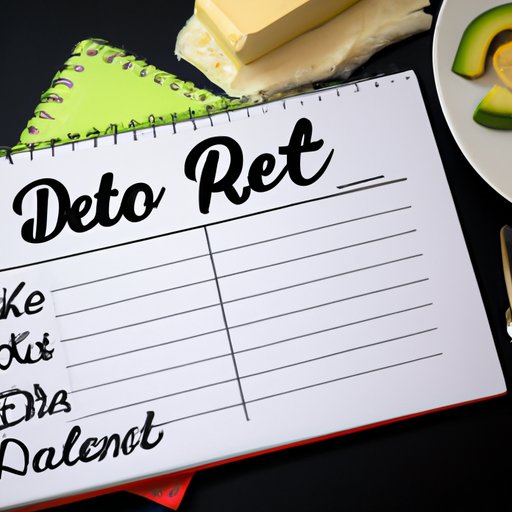
Introduction
If you’re looking for a diet plan that can help you lose weight effectively and optimize your overall health, you might want to consider the keto diet plan. The keto diet is a low-carb, high-fat diet that can help your body enter a state of ketosis, where it starts burning fat for fuel instead of glucose.
In this article, we will provide you with a comprehensive guide to the keto diet, including its definition, history, benefits and drawbacks, macronutrient ratios, meal planning advice, and more. Whether you’re a beginner or someone who has been following the keto diet for a while, we hope you will find this guide helpful in your journey towards a healthier and more fulfilling lifestyle.
Keto 101: An Introductory Guide to the Keto Diet Plan
The keto diet plan is a low-carb, high-fat diet that can help your body enter a state of ketosis, where it starts burning fat for fuel instead of glucose. This type of diet can help you lose weight effectively, improve your energy levels, and reduce your risk of chronic diseases such as diabetes and heart disease.
The keto diet plan was first introduced in the 1920s as a therapeutic way to treat epilepsy, especially in children who did not respond well to medication. Over time, researchers began to recognize its potential benefits in other areas such as weight loss and blood sugar control.
While the keto diet plan can offer numerous health benefits, it’s important to be aware of its potential drawbacks such as the risk of nutrient deficiencies, the possibility of experiencing the “keto flu,” and the challenges of maintaining this type of diet in the long term.
Everything You Need to Know About the Ketogenic Diet Plan
The key to the keto diet plan is to eat high amounts of healthy fats, moderate amounts of protein, and very low amounts of carbohydrates. Generally, the ideal macronutrient ratio for the keto diet is 70-80% fat, 20-25% protein, and 5-10% carbs.
When you eat this way, your body enters a state of ketosis, where it starts producing ketones – small molecules that are used for fuel instead of glucose. This can lead to various health benefits such as weight loss, improved brain function, reduced inflammation, and more.
There are different types of keto diets such as the standard keto diet, the targeted keto diet (which allows you to eat a small amount of carbohydrates around your workouts), and the cyclical keto diet (where you alternate between periods of high-carb and low-carb eating).
Maximizing Weight Loss with a Keto Diet Plan
One of the main benefits of the keto diet plan is its ability to help you lose weight effectively and sustainably. When you eat a high-fat, low-carb diet, your body enters a state of ketosis where it starts burning fat for fuel instead of glucose. This can lead to a significant reduction in body fat and an increase in lean muscle mass.
When starting on a keto diet, it’s important to set realistic and achievable weight loss goals. Depending on your starting weight and other factors, aiming to lose 1-2 pounds per week can be a reasonable target.
Here is an example of a meal plan for weight loss on a keto diet:
- Breakfast: 2 eggs cooked in 1 tbsp of butter, 1 slice of bacon, 1 cup of coffee with heavy cream
- Lunch: Grilled chicken salad with mixed greens, avocado, olive oil, and balsamic vinegar
- Dinner: Baked salmon with asparagus and roasted cauliflower
- Snacks: 1 oz of mixed nuts, 1 medium-sized avocado
A Beginner’s Guide to Meal Planning on a Keto Diet
When planning your meals on a keto diet, it’s important to focus on whole, nutrient-dense foods that are low in carbohydrates and high in healthy fats. This includes foods such as meats, seafood, eggs, nuts and seeds, low-carb vegetables, and healthy fats such as coconut oil, olive oil, and avocado oil.
Here are some tips for grocery shopping and meal prepping on a keto diet:
- Make a shopping list before going to the store to avoid impulse buys
- Choose organic and grass-fed meats when possible
- Stock up on keto-friendly healthy fats such as olive oil, coconut oil, and avocado oil
- Include a variety of low-carb vegetables such as spinach, kale, broccoli, and cauliflower
- Prepare meals in advance to save time and stay on track
When eating out, you can choose keto-friendly options such as salads with healthy fats and proteins, grilled meats or fish with veggies, or omelets with cheese and veggies.
Ketosis: The Science Behind the Keto Diet Plan
Ketosis is a metabolic state where the body uses ketones for fuel instead of glucose. This happens when you eat a low-carb, high-fat diet such as the keto diet plan.
While in a state of ketosis, your body can experience various health benefits such as reducing inflammation, improving brain function, and reducing your risk of chronic diseases such as diabetes and heart disease.
However, it’s important to be aware of the possible side effects of a keto diet such as the “keto flu” (which can occur during the initial phase of transitioning to a keto diet), constipation, and nutrient deficiencies. It’s also important to ensure that you’re eating a balanced and varied diet that provides all the necessary nutrients for optimal health.
Conclusion
The keto diet plan can be an effective and sustainable way to lose weight and optimize your overall health. By following the tips and guidelines provided in this article, you can learn how to eat a keto-friendly diet that is both nutritious and delicious.
Remember to set realistic and achievable goals, focus on whole, nutrient-dense foods, and listen to your body’s needs. With a little bit of effort and commitment, you can achieve your health and fitness goals with the keto diet plan.




